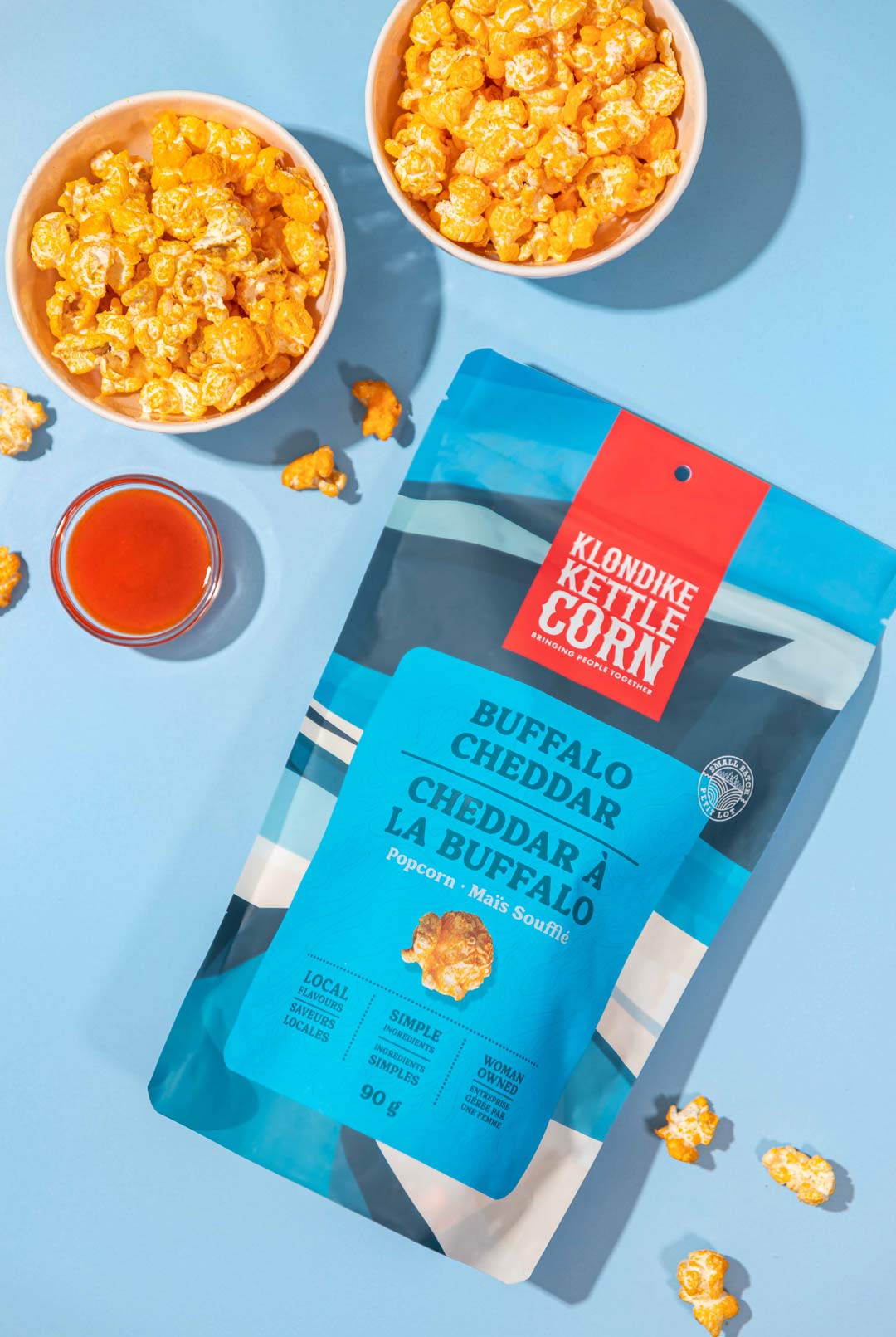
For this sustainable design case study, we interviewed designer Elise Cheetham, based in Vancouver, BC. If you’d like to have your sustainable work featured, please fill out our case study Q&A.
What was the main goal of this project and the design objective toward that goal?
The goal was to re-fresh the packaging design of Klondike Kettle Corn to evoke an authentic Yukon experience while solidifying the brand personality & tone as fun, casual, and outgoing. Simple graphics of outdoor landscapes and a typographic pattern are featured, visually inviting consumers to experience a taste of the Yukon with locally sourced ingredients — perfect for eating now and for bringing a bit of the North back home.
What sustainability opportunities did you see?
I saw an opportunity to print more sustainably with a substrate that is compostable, use a local vendor that prioritizes sustainability, and provide accessibility recommendations for their website refresh.
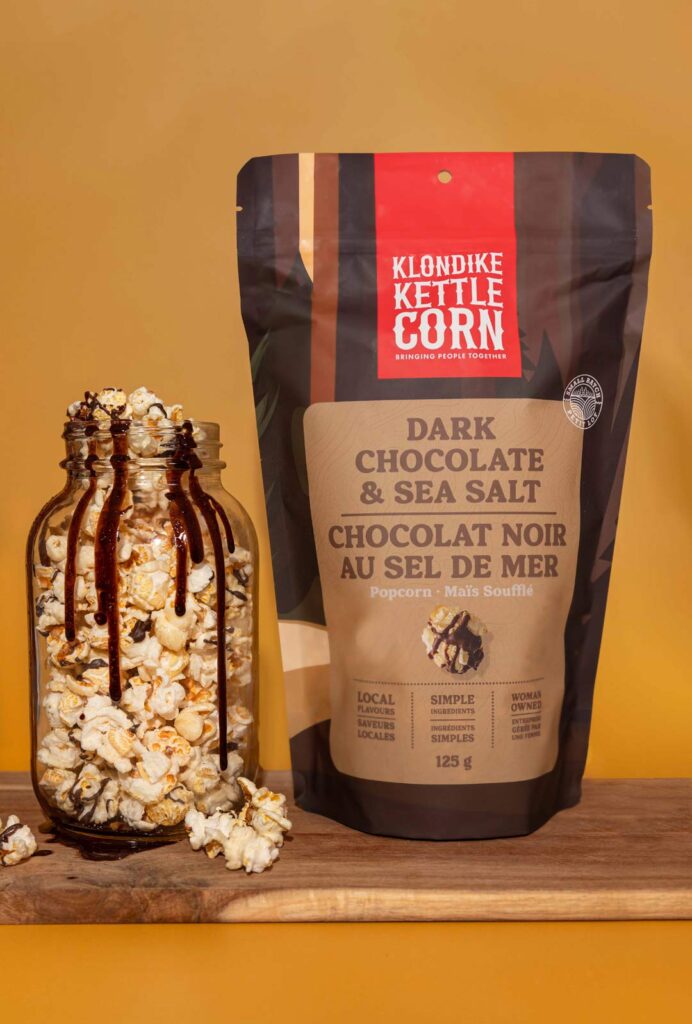
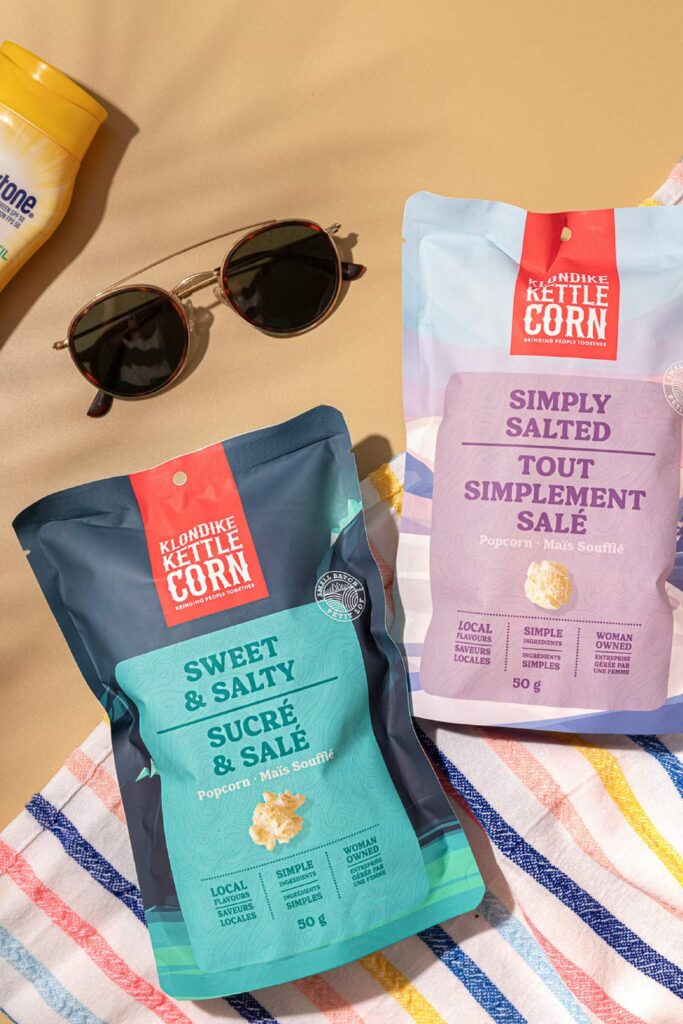
Did your client come to you with sustainability requirements? If not, how did you encourage and/or support your client to make more sustainable choices?
Although there were no specific sustainability requirements, I encouraged Klondike Kettle Corn to proceed with compostable bags and work with a Canadian print company, rather than printing overseas, to reduce their carbon footprint.
I suggested they conduct a survey, asking existing consumers, “how important is the sustainability of the packaging to you?” The results revealed that the sustainability of the packaging mattered, with consumers giving it a high rating on a scale from 1–10. This information was valuable and directly informed the client that sustainable packaging was a priority to Klondike Kettle Corns consumers.
A lot of thought went into the design of the new packaging, especially where we were going to source it from. Katie Young, founder of Klondike Kettle Corn, discovered an innovative Vancouver-based company called ePac who offer a digital printing platform that is inherently sustainable. Their technology uses less energy, produces less waste and has a smaller carbon footprint than traditional printing technologies. With Klondike Kettle Corns packaging printed in BC, it doesn’t have far to go and reduces the amount of carbon emissions during transportation. The packaging reduces food waste due to releasability, extends product shelf life and requires less energy and resources to produce then traditional packaging.
Klondike Kettle Corn decided to work with ePac Flexible Packaging, who are committed to creating a more sustainable world through earth-friendly packaging solutions, an energy-efficient production process, and involvement in local communities.
“I believe our packaging appealed to retailers and they were excited to try a high velocity, low cost product in their stores. Our sales more than doubled from the previous year.”
— Katie Young, founder, Klondike Kettle Corn
One of the benefits of working with a sustainable-minded company is that they have goals to strive for. Klondike Kettle Corn is working towards printing with a post-consumer recycled (PCR) film, another environmentally friendly packaging option. After recyclable packaging (such as milk cartons or water bottles) have fulfilled their life cycle, they are diverted from landfills and converted into other commodities, such as new packaging material. The new packaging uses ~28% less virgin polymer, since it’s replaced by PCR resins. By using PCR films in packaging, greenhouse gas emissions are reduced by ~15.25%. *Source: How2Recycle
ePac’s HP digital printers consume less energy and emit fewer greenhouse gases than traditional printers. Their polymer-based inks are compostable and don’t contain hazardous air pollutants.
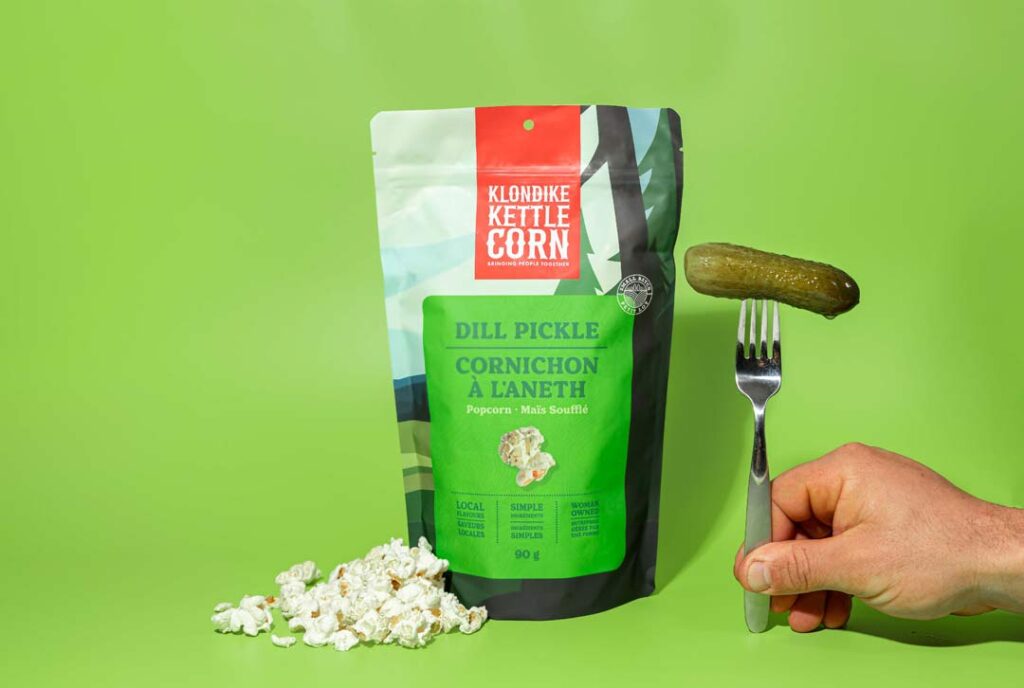
What sustainable choices did you make and/or advocate for? It would be helpful to hear more about which sustainable design pillars apply to this project (environmental, social, cultural, economic):
Klondike Kettle Corn agreed to hire a Canadian print company as opposed to printing overseas. They also used a local, women-owned photography company, Better Yet Creative.
Beyond greener printing options, I provided colour codes for the website refresh that followed digital accessibility practices with contrast ratios that meet the ADA and WCAG guidelines for large and small text and by analyzing colour contrast with WCAG 2.2 web accessibility contrast checkers. This ensures the digital content is more accessible for individuals with disabilities and user friendly for everyone.
As a designer with Scotopic Sensitivity syndrome (also known as Irlens Syndrome), a perceptual processing disorder, I personally understand the impact and social value of accessibility and how design plays a role in making an impact on people’s lives.
What challenges or barriers did you encounter in doing sustainable design, if any, and how did you overcome them?
The main challenge for Klondike Kettle Corn was cost. Packaging is one of their highest costs to consider and they would have to order a significant amount of packaging to keep their costs low, while other supplies can be ordered in smaller quantities throughout the year.
While it would have been an added benefit to have compostable packaging, my client had reservations about pursuing it yet:
“Compostable bags are still controversial in the [Consumer Packaged Goods] industry. The quality just isn’t there yet. When we looked into it the shelf life of the bags were 6 months, so our product shelf life exceeded the bags. The level of compostability is also questionable. Zippers need to be removed and layers are limited — affecting the shelf life. We are interested in following this, but the solution just isn’t there yet,” said Katie Young.
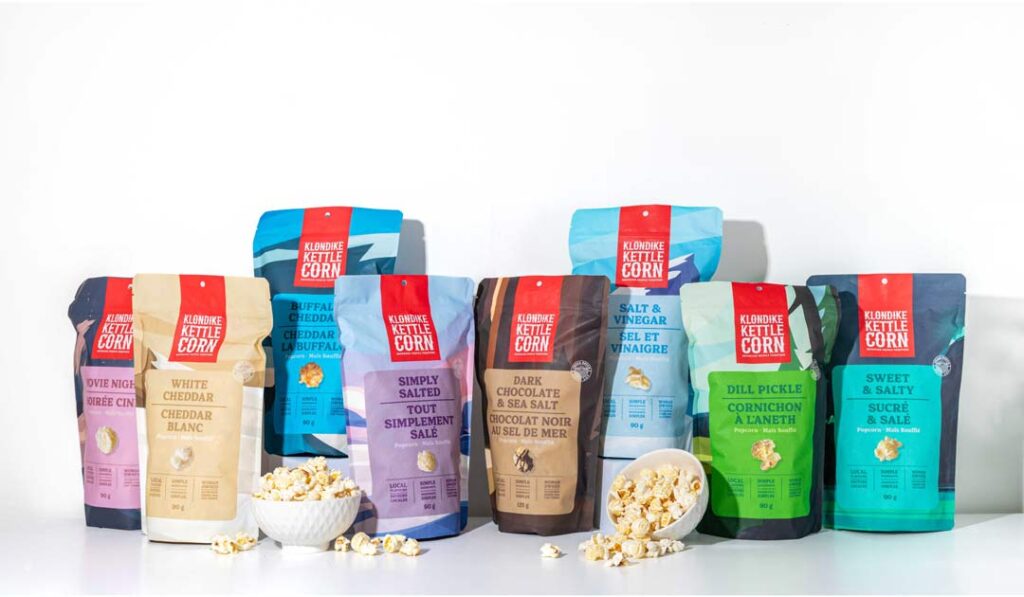
What was the most insightful thing you learned practicing sustainable design on this project?
I learned that as designers the more we make recommendations and advocate for sustainable design the more we learn. Business owners — especially in the early stages — are working with so many different aspects of the business and it can be overwhelming to put the research into who to work with and to emphasize the importance of sustainability. I have gained immense knowledge from my peers as a member of the DesCan Sustainability committee and was able to directly inform my client’s sustainability practices, primarily in sustainable printing options and digital accessibility practices.
Were you able to measure any tangible impacts of your work? How did you do this?
Katie Young: “Our new packaging design was very important in the expansion of our business outside of the Yukon. Industry standards for shelf life on snack products is at least 6 months and favourable for 12 months. This is only achieved with high quality packaging. Our new packaging design also appeals to a more national audience. Previously our labels were focused on a Yukon customer with a heavy influence from outdoor activities. We were able to maintain this outdoor vibe for a national audience by appealing to the magic of the Yukon. Our packaging does a great job of telling our story and inviting the customer to taste the magic of the Yukon. For retailers, the packaging is easily merchandisable in a stand-up pouch, with a hang hole. After updating our packaging we saw an increase in sales through Faire.com. This is an online store for wholesale customers — often smaller, independent stores. I believe our packaging appealed to retailers and they were excited to try a high velocity, low cost product in their stores. Our sales more than doubled from the previous year.”
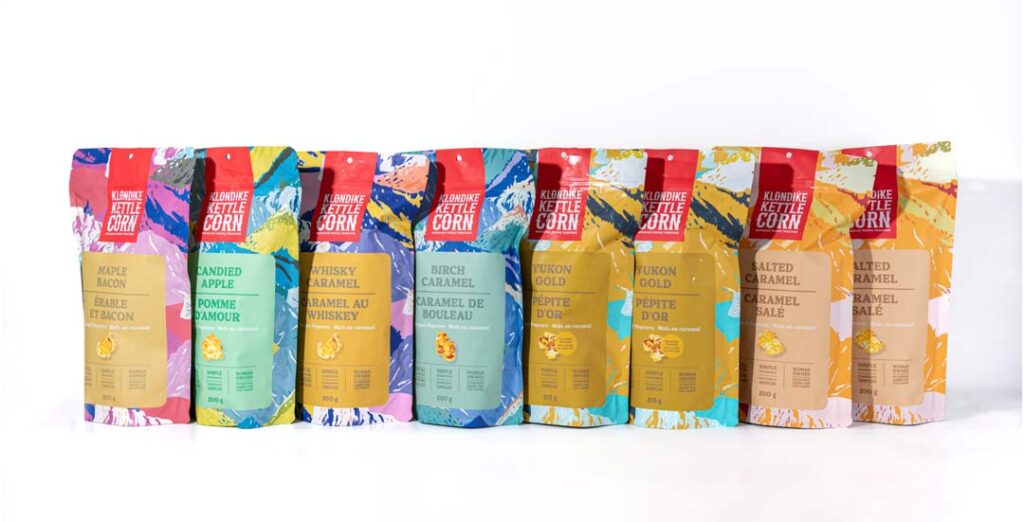
Please share about why sustainable design is important to you…
Design has immense potential to help improve the human condition and the global environment. As designers we have an opportunity to inform and educate on ways we can make the world a better place.
Any final thoughts or sustainability advice for designers, colleagues, clients, and design students?
Sustainability might be at the forefront of your client’s mind, so it is a great opportunity to educate and promote sustainable options. It can often be overlooked that a designer’s role can extend beyond merely designing a product, but to also consult and provide recommendations for print vendors with sustainability as a priority.
In this case my client sourced her own vendor with sustainable print options. However, our initial discussions sparked awareness and consideration of sustainable printing. I encourage other designers to use client consultations as an opportunity to initiate conversations around sustainability.